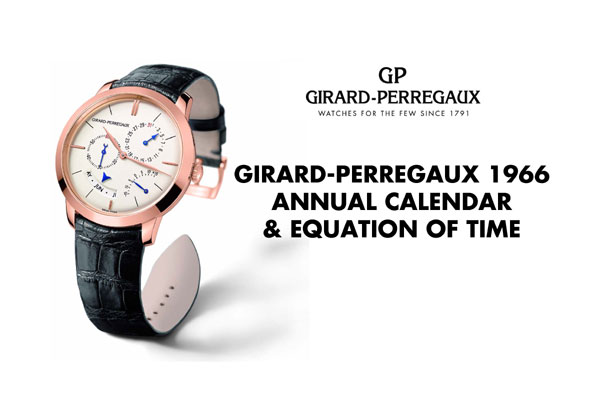 | |
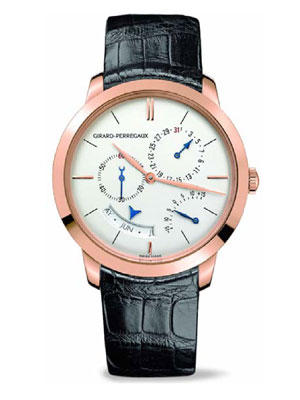 |
CASE Material: pink gold Diameter: 40.00 mm Height: 10.72 mm Crystal: sapphire antireflective Case-back: sapphire crystal, press-in Water resistance: 3 atm MOVEMENT Movement: Girard-Perregaux GP033M0, automatic Calibre: 11½’’’ Frequency: 28,800 vibrations/hour (4 Hz) Power reserve: min. 46 hours Jewels: 44 Balance wheel: Microvar Functions: hour, minute, small seconds, annual calendar, equation of time STRAP Material: alligator Strap size: 20.00/16.00 mm Strap reference: BC2016-BK60-3BF-F Buckle: pin buckle Buckle reference: B/A.1652A-A52A1 (Pink gold) Reference: 49538-52-131-BK6A |
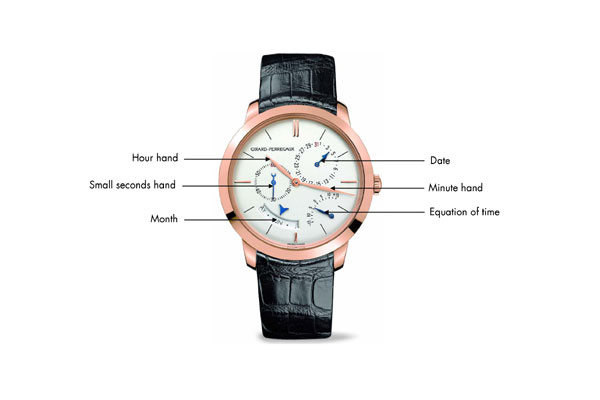 | |
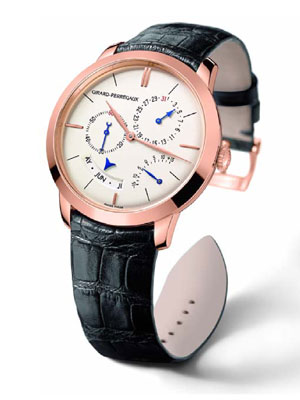 |
CALENDAR INDICATIONS Date: a calendar that displays the day of the month. Day-date: a calendar that displays the day of the week and the date. Triple calendar: a calendar that displays the day of the week, the date and the month. Full calendar: a triple calendar with moon phases indication. Annual calendar: a calendar that automatically corrects for the differing durations of the months and needs no more correction than once a year. For the GP1966 annual calendar, a correction is needed for each February 28 except for the leap years. Perpetual calendar: a calendar that automatically corrects for the differing duration of months and leap years. |
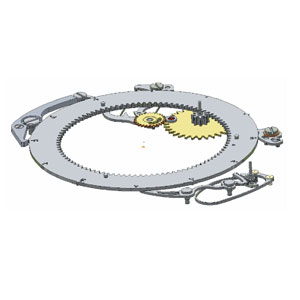 |
THE GP033M0 MOVEMENT One of the latest development from our R&D department, the GP033MO movement features an annual calendar and the equation of time display. The complication is based on a classic mechanism from Girard-Perregaux (Equation line) modernized into a new module. The annual calendar mechanism is based on an original design. A disc which completes one rotation per year features lugs which activate a correction mechanism for months without 31 days. The correction is performed with the crown ( correction for each February 28 except for the leap years). The equation of time mechanism features an ellipsoidal wheel, which allows to display the difference between civil time and real solar time. Several mechanisms have been replaced by flexible parts manufactured by LIGA technology, the combination of photo-lithography and electro-forming technologies. A technology which enables very accurate shapes and multi-depth levels to be manufactured. |
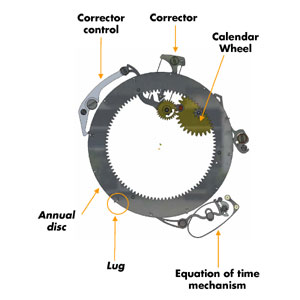 |
The ANNUAL CALENDAR MECHANISM The annual calendar mechanism is based on an original construction. A disc which completes one rotation per year is fitted with lugs, which activate a correction control for months without 31 days (30-day months and February 29). An easy and user-friendly correction mechanism: all corrections are performed with the crown (3 corrections in 4 years). One rotation of the crown advances the date by 5 days. |
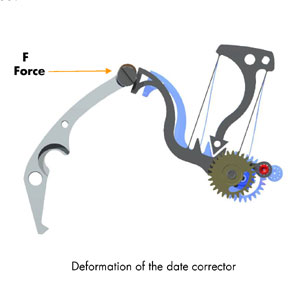 |
FLEXIBLE PARTS Several mechanisms have been replaced by flexible nickel parts manufactured using LIGA technology. These parts have the advantage of replacing complex mechanisms by a single component: - No friction, - No ageing and wear of parts, - No oiling needed. |
| LIGA TECHNOLOGY LIGA (an acronym from German words for lithography, electroplating and molding) is a micromachining technology that originated in the early 1980s at the Karlsruhe Nuclear Research Center. This technology first developed for medical applications, is now used for creating microcomponents of very high quality, in particular flawless movement components. It also enables innovative components in terms of shape and function to be developed. Thanks to the combination of photo-lithography and electro-forming it is possible to realize highly accurate shapes, with an outstanding surface quality and precision. 1.The lithographic process is based on a photo mask containing the precise shape of the part to be manufactured. A solvent is used to leave behind the structure of non ultra-violet irradiated polymer as the primary structure. 2. Electro-forming then enables components to be grown in a plating bath in the structure generated by the lithographic process. | |
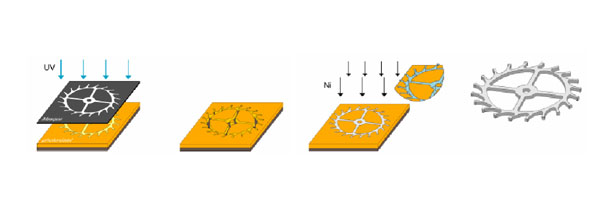 | |
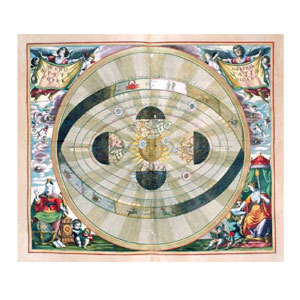 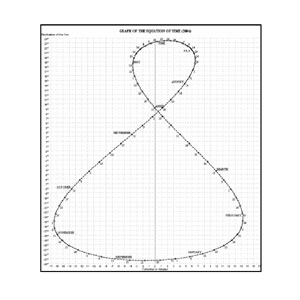 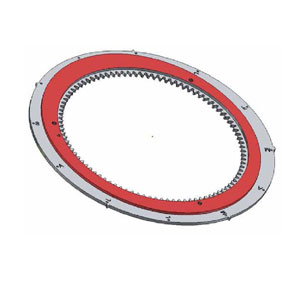 |
EQUATION OF TIME The equation of time is a physical effect which measures the difference between the mean time (or civil time) and the real solar time. This difference is due to the Earth’s elliptical orbit (not round). As a result, the actual length of a day is not 24 hours. This difference varies between -16 and +16 seconds daily which makes a maximum annual difference of +14 and -16 minutes. The 24-hour day measured by most watches is the civil time which represents a compromise of the variation. The indication of the equation of time, vital for astronomers and navigators, has aroused the interest of every great watchmaker. Amongst other things, it can be used to determine the times of sunrise and sunset. The difference between real solar time and civil time is charted in a graph known as an “ Analemma”. From this graph, it is noticeable that: - the greatest positive variance occurs in February - the greatest negative variance occurs in November - there are four days in a year in which civil time and real solar time are the same: April 15, June 14, September 1 and December 24. These days are shown on the zero axis. The equation of time mechanism is based on several parts including the annual disc which features an ellipsoidal cam. As part of the annual disc, this ellipsoidal cam (pictured in red) completes a rotation once per year. The cam, designed through precise calculation, corresponds to the ellipsoidal shape of the equation of time “Analemma” to reproduce the irregular movement of the Earth around the Sun. It rotates at a constant rate and gives information to an arm resting against it. The difference between civil time and real solar time is then displayed by the equation of time hand. |
| THE MECHANISM The feeler-spindle (a) rests lightly against the ellipsoidal cam to read the equation of time information (+14 to -16 minutes). A spring (b) is used for: - regulating and balancing the power between the feeler-spindle and the equation of time wheel - maintaining the feeler-spindle against the equation of time cam (ellipsoidal wheel). | |
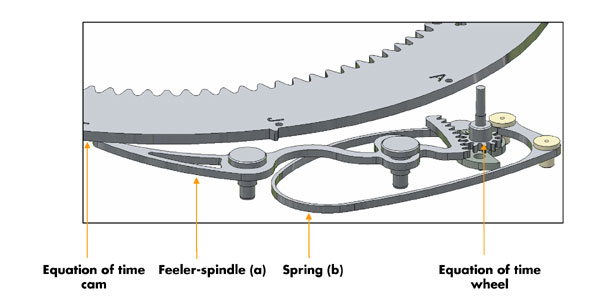 | |
| GIRARD-PERREGAUX MICROVAR The GP033M0 movement is equipped with the Microvar free-sprung balance. Free-sprung balance wheels are widely recognized as being the most prestigious type of balance. The result of years of research and development, the Microvar balance wheel is a distinctive element exclusive to Girard-Perregaux. The six external gold screws on the side of the rim are used for poising the balance; the two weights on the top to adjust the watch rate. This design provides greater precision in regulation and more stability over time. To achieve greater precision and regularity in adjustment, an eccentric fine adjustment mechanism has been developed. For a perfect beat, the spring should be perfectly centered. Turning the eccentric adjustment screw in one direction or the other enables the balance spring mounting on the stud to be moved. The use of a fine adjustment system facilitates this operation. The watchmaker is able to make adjustments more easily and more precisely. | |
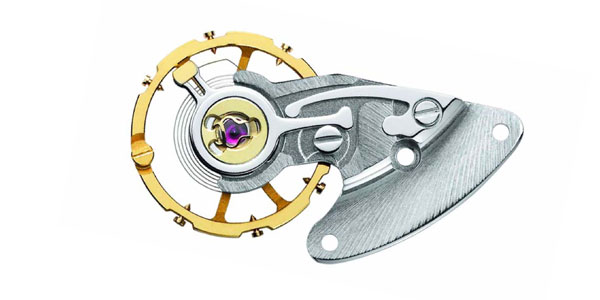 | |